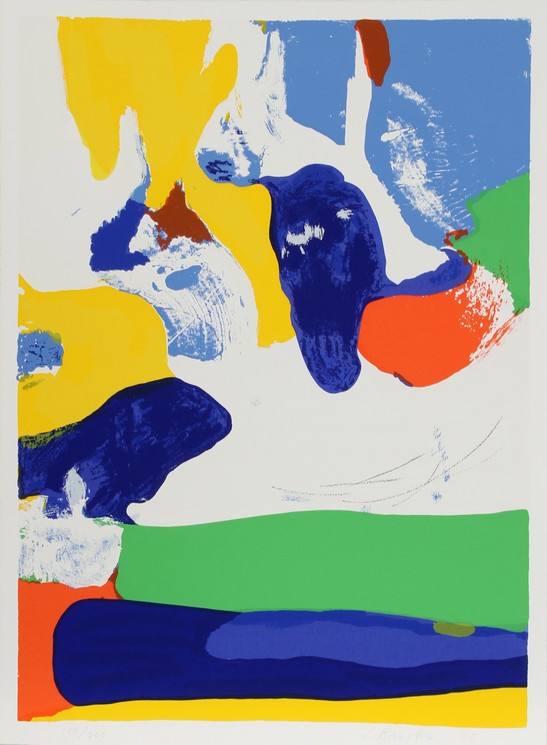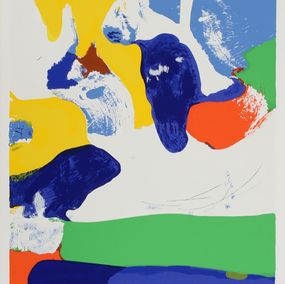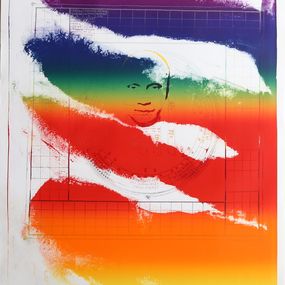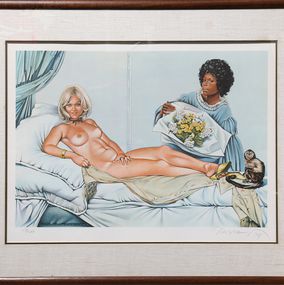
Concord,
1976
James Brooks
Print : Screen Print
76.2 x 55.9 x 0.5 cm 30 x 22 x 0.2 inch
One of the last works available by this artist
Free returns within 14 days
Authenticity guaranteed
Learn moreSecure payment
About the artwork
Type
Numbered and limited to 200 copies
1 copy available
Signature
Hand-signed by artist
Authenticity
Invoice from the gallery
Medium
Dimensions cm • inch
76.2 x 55.9 x 0.5 cm 30 x 22 x 0.2 inch Height x Width x Depth
Support
Framing
Not framed
Artwork sold in perfect condition
Artwork location: United States
Concord:
James Brooks, American (1906–1992)
Portfolio: America: The Third Century Portfolio
Date: 1976
Screenprint, signed and numbered in pencil
Edition of 200
Size: 30 x 22 in. (76.2 x 55.88 cm)
Printer: Styria Studio

Presentation
James Brooks, muralist and abstract painter, was born on October 18, 1906, in St. Louis, Missouri, one of four children of William Rodolphus and Abigail F. (Williamson) Brooks. His father was a traveling salesman, and the Brooks family moved frequently until 1916, when they settled in Dallas. Following his graduation from Oak Cliff High School in 1922 Brooks studied art at Southern Methodist University for two years. He then studied with James A. Waddell at the Dallas Art Instituteqv and took private lessons with Martha Simkins.qv In 1926 he moved to New York City, where he worked as a commercial artist to fund his night classes with Boardman Robinson and Kimon Nicolaides at the Art Students League.
Brooks began exhibiting paintings and prints in a social realist style in various group shows around New York in the early 1930s. He executed three murals for the WPA Federal Art Project between 1936 and 1942, during which time he met the painters Jackson Pollock and Philip Guston. His best-known mural, Flight, runs 235 feet around the rotunda of the Marine Air Terminal at La Guardia Airport in Queens. The mural was painted over without explanation in the 1950s, possibly because some saw left-wing symbolism in it, but following the protests of art historians and curators it was fully restored in 1980. Brooks enlisted in the United States Army in 1942 and served as an art correspondent in Egypt and the Near East.
He spent the last few months of the war at the Office of Special Services in Washington, D.C. Upon his return to New York in September 1945 he renewed his friendships with Guston, Pollock, and Bradley Walker Tomlin and began to solicit criticism from Wallace Harrison. Brooks developed an abstract style influenced by the synthetic Cubism of Pablo Picasso and Georges Braque. In the summer of 1948 he developed a more fluid abstract style after being inspired by the random shapes that occurred on the back of canvases to which he had glued paintings with black paste. He subsequently executed a series of stained and dripped canvases that were featured at his first solo exhibition the following year at the Peridot Gallery in New York City.
Many of Brooks's early works in the Abstract Expressionist style retained vestiges of the Cubist grid. He experimented with enamels, gouache, and thinned oils over various backgrounds such as crayon; his palette generally alternated between browns, grays, or blacks and more vivid colors. Later in his career Brooks introduced more assertive forms, but shied away from developing any dominant method or style, wishing to avoid "nausea with one's own pictorial clichés." In the late 1960s he switched from oils to acrylics, a change that prompted the use of a wider range of colors, broader strokes, and simpler compositions with larger color areas. He used numbers and letters to identify his paintings. He frequently added nonsense syllables to the letters as a mnemonic device, forming such titles as Pask, Burwak, and Jondol. Although Brooks's service in the army excluded him from participation in ground-breaking exhibitions at Peggy Guggenheim's Art of This Century gallery, he has nevertheless been considered by critics to be a member of the first generation of Abstract Expressionists. He participated in many group exhibitions around the country, among the most important being the historic, artist-organized Ninth Street Exhibition (1951), which included the work of Pollock, Hans Hofmann, Franz Kline, Willem de Kooning, and Robert Motherwell, and two influential exhibitions organized by the Museum of Modern Art in New York City, Twelve Americans (1956) and New American Painting (1959). His work has been featured in many solo exhibitions; retrospectives of his work were organized by the Whitney Museum of American Art in New York (1963) and the Dallas Museum of Fine Arts (1972).
Throughout his career Brooks supplemented his income from painting with teaching posts at various institutions, including Columbia University, New York (1946-48); Pratt Institute, New York (1948-58); Yale University, New Haven, Connecticut (1955-60); New College, Sarasota, Florida (1965-67); Miami Art Center, Miami, Florida (1966); Queens College, Queens, New York (1966-69); Southampton College of Long Island University, Southampton, New York (1968); and the University of Pennsylvania, Philadelphia (1971-72). He was the artist-in-residence at the American Academy in Rome, Italy, in 1963. Brooks was awarded a Guggenheim Fellowship in 1969 and in 1973 was elected to membership in the National Institute of Arts and Letters. James Brooks married Mary MacDonald in 1938 and in 1947 married Charlotte Park. He developed Alzheimer's disease in 1985 and died on Long Island on March 9, 1992.
Examples of his work are at the Brooklyn Museum, the Detroit Institute of Art, the Solomon R. Guggenheim Museum and the Museum of Modern Art in New York, the Tate Gallery in London, the Whitney Museum of American Art in New York, the Museum of Fine Arts, Houston,qv the Art Institute of Chicago, the Boston Museum of Fine Arts, the Dallas Museum of Art,qv the Metropolitan Museum of Art, New York, Southern Methodist University, Dallas, and the Archer M. Huntington Art Gallery,qv Austin.
Bibliography: Sam Hunter, James Brooks (exhibition catalog, New York: Frederick A. Praeger, 1963). James Brooks: Paintings, 1952-1975; Works on Paper, 1950-1975 (exhibition catalog, New York: Martha Jackson Gallery, 1975). New York Times, March 12, 1992 A painter of both Social Realism and Abstract Expressionism and part of the so-called New York School, he achieved much renown but not as much as his contemporaries Mark Rothko, Jackson Pollock, and Franz Kline.
Many of his paintings are huge, expressing a sense of cosmic space as though a high-powered telescope were penetrating space so deeply that one feels the color, the form, and the surge of movement. He used much black, so that darkness seemed equal to the other colors of his canvases and convey a sense of void amongst floating and colliding bright colors. He was born in St. Louis, Missouri and during his childhood, moved frequently throughout the Southwest. In the mid and late 1920s in Dallas, Texas, he attended Southern Methodist University and the Dallas Art Institute.
In 1926, he moved to New York City and worked as a commercial lettering artist, while taking night classes at the Art Students League from 1927 to 1930. From 1931 to 1934, he traveled and painted in the American West and Southwest, painting in a Social Realist style. Between 1936 and 1942, he worked on murals for the WPA Federal Art Project including ones for Queensborough Public Library, Woodside Branch Library, and La Guardia Airport. The LaGuardia mural called "Flight," later destroyed, was especially impressive and huge--12 feet by 235 feet. He served in North Africa as an army artist during World War II, and the end of this service also marked the end of his painting in realistic styles. In 1949, having observed Jackson Pollock's drip style, Brooks experimented with pouring pigment on the back of unsized canvas, and became much lauded for his achieving of balance between spontaneity and control. In 1953, he abandoned that technique for much more densely packed, tightly controlled structure resembling Cubism. In the early 1960s, he added linear calligraphy to his painting.
Printmakers
American artists
More works from RoGallery
Artsper delivers internationally. The list of countries is available in the first step of your cart.
If your country is not listed contact us at [email protected] and we will see what we can do.
Note that Customs fees may apply for works shipped internationally. This is indicated in the first step of the shopping cart.
You can choose a delivery address different from the billing address. Make sure that a trusted person is present to receive the work if you cannot be there.
Have you purchased a painting, sculpture or work on paper?
Find our expert advice for the conservation and promotion of your works in the articles below:
Artsper offers you access to more than 200,000 works of contemporary art from 2,000 partner galleries. Our team of experts carefully selects galleries to guarantee the quality and originality of the works.
You benefit from:
-
Works at gallery price
-
Return within 14 days, regardless of your location
-
Easy resale of the work purchased on Artsper
-
Personalized research tools (selection and tailor-made universe)
Our customer service is available for any assistance.
At Artsper, our mission is to allow you to collect works of art with complete peace of mind. Discover the protections we offer at every stage of your shopping experience.
Buy works from top galleries
We work in close collaboration with carefully selected art galleries. Each seller on Artsper is carefully examined and approved by our team, thus ensuring compliance with our code of ethics. You therefore have the assurance of purchasing authentic, high-quality works.
Total transparency: you know what you are buying
Before being posted online, all artwork on Artsper is reviewed and validated by our moderation team. You can browse with complete peace of mind, knowing that each piece meets our criteria of excellence.
Personalized support: our experts at your service
Our team of contemporary art experts is available by phone or email to answer all your questions. Whether you want advice on a work or a tailor-made selection to enrich your collection, we are here to support you.
Resell your works with ease
If you have purchased a work on Artsper and wish to resell it, we offer you a dedicated platform to relist it. To find out more, click here.
Make offers with Artsper: negotiate like in a gallery
You have the possibility to propose a price for certain works, just like in a gallery. This feature allows you to initiate discussions and potentially acquire your coins at advantageous prices.
Get help with your negotiations
Our team will negotiate for you and inform you as soon as the best offer is obtained. Do not hesitate to call on our expertise to ensure a transaction at the best price.
Order securely
Artsper satisfaction assurance
We want you to be completely satisfied with your purchase. If the work you receive is not to your liking, you have 14 days to return it free of charge, and you will be refunded in full, whatever the reason.
Secure payment with Artsper partners
All credit card payments are processed by Paybox, the world leader in payment solutions. Thanks to their strict security standards, you can transact with confidence.
Problem Support
In the rare event that an artwork arrives damaged or not as described, we are here to help. Whether for a return, refund, restoration or exchange, our team will support you throughout the process and will ensure that we find the solution best suited to your situation.
Conditions to benefit from Artsper protections:
-
Use one of the payment methods available on Artsper for your order.
-
Report any problems within one week of receiving the work.
-
Provide required photographic evidence (including original artwork and packaging).
Artsper guarantees cover the following cases:
-
The received work lacks a described characteristic (for example, a signature or frame).
-
The artwork has significant differences from its description (e.g. color variation).
-
The work is damaged upon receipt.
-
The work is lost or damaged by the carrier.
-
Delivery is significantly delayed.
With Artsper, you collect with complete peace of mind.















